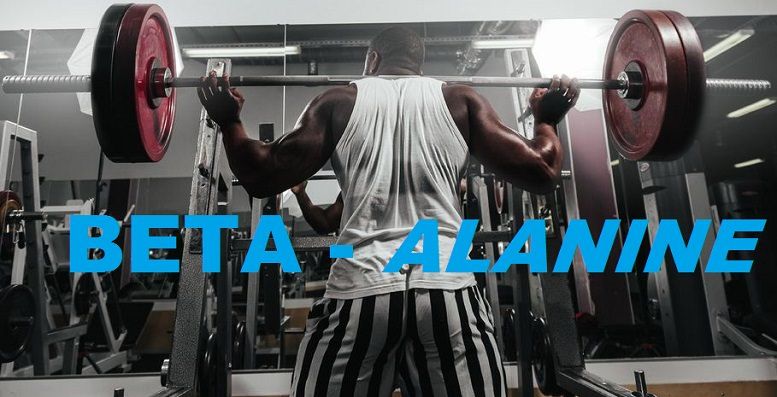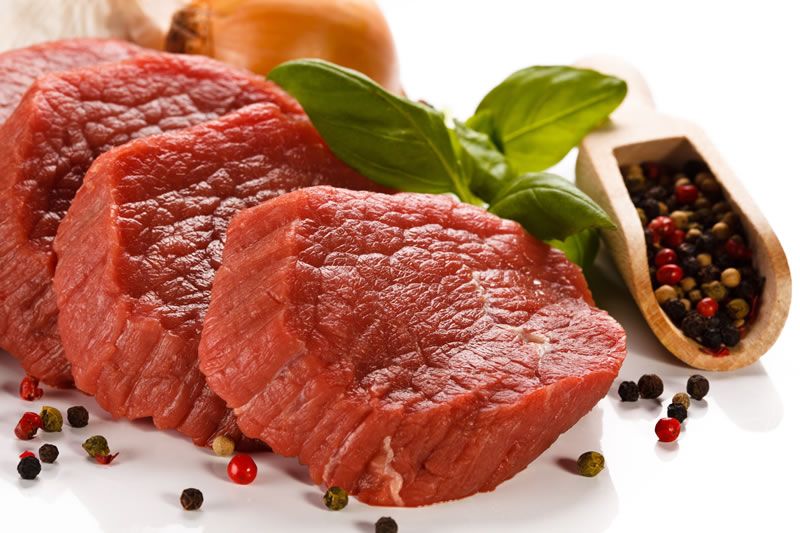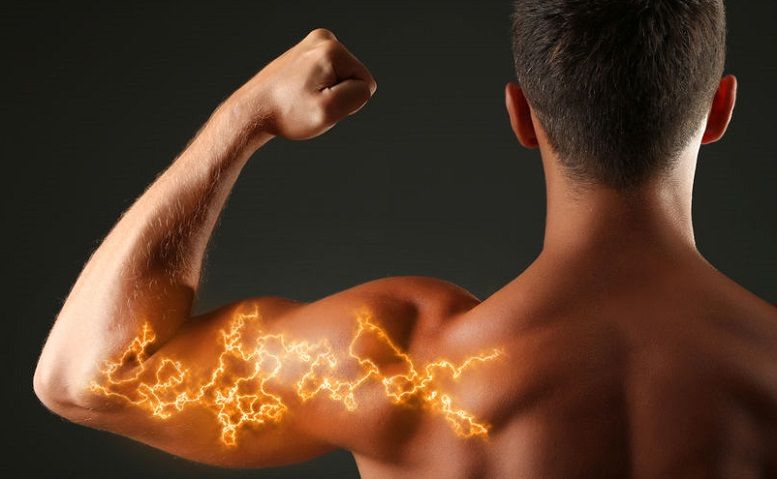Table of Contents
Beta-alanine is a non-essential amino acid that has come to the attention in the world of fitness and bodybuilding very quickly. Beta-alanine or 3-aminopropionic acid is a naturally occurring amino acid and a constituent of the histidine dipeptides of carnosine and anserine, as well as vitamin B5 or pantothenic acid.
Its composition is a hybrid between the potent neurotransmitters L-glycine and GABA, which may explain why its consumers often experience a caffeine-like effect. This amino acid is also slowly gaining popularity within the scientific community as it is classified as a neurotransmitter.

The human body can produce Beta alanine in at least three ways. It may be released during the resolution of histidine dipeptides such as carnosine. The second method is formed as a by-product of the reaction where it converts L-alanine to pytuvate. The third method is during digestion, when the red microorganisms remove the carbon atom from the L-aspartate.
When consumed as a dietary supplement, it passes from the blood to the skeletal muscle through a carrier that is dependent on sodium and chloride. Upon entering the skeletal muscle cell, it binds with the essential amino acid L-histidine to form the carnosine dipeptide [1]
Beta alanine is also known for the harmless feeling of “itching” that it causes in the body. Surely this feeling surprised you when you first received it as a part of a pre-workout.
Who is Beta alanine suitable for?
1. Strength training people who want to gain muscle mass and increase strength.
2. Anyone who needs to increase strength, energy and endurance.
3. Active individuals who have reached their maximum and are trying to take training to the next level. [2]
You might be interested in these products:
What’s its main purpose?
C. Sale, B. Saunders and R. Harrison have shown that Beta alanine supplementation increases muscle carnosine concentration by up to 58% in 4 weeks and by 80% in 10 weeks. [3]
Carnosine is a powerful antioxidant and peptide that protects muscles from accumulating hydrogen ions (H +) during exercise. An increase in H + decreases the pH in muscle cells and increases the energy in the muscles.

Muscle carnosine concentration is also associated with a high percentage of fast type 2 muscle fibers. For this reason, you will find higher levels of muscle carnosine among sprinters. Men generally have higher muscle carnosine concentrations than women.
What are the food sources for Beta alanine?
Beta alanine is derived from animal protein and its best sources include pork, beef and tuna.
It is also a common part of many pre-training stimulants, and is also available as a separate substance. Pre-workout accessories labels are often labeled with the CarnoSyn® brand, which is manufactured by a patented process. [1]

Beta-alanine increases:
- explosive muscle strength and performance,
- muscle mass,
- anaerobic endurance,
- aerobic endurance,
- physical fitness so you can train harder and longer. [2]
Use of Beta alanine in sports
In one of the first published studies on Beta alanine and sports performance, subjects received either placebo, 20 g creatine monohydrate daily, 800 mg Beta alanine four times a day, or the same dose of Beta alanine with 20 g creatine monohydrate. During the 4-minute cycling test, performance was significantly increased in both the Beta Alanine groups compared to the placebo or creatine group. The most significant improvement was noted during the first and fourth minutes of cycling. [4]
In another study, football players who took 3.2 g of Beta alanine per day for 12 weeks during the competition season were tested. Unlike the placebo group, their performance with Beta alanine was improved by 34.3%. Beta alanine improved player performance from 0 to 72.7%, while for placebo the response range was between -37.5 and 14.7%. [5]

Scientists from the UK have provided evidence that only 6 grams of Beta alanine over 4 weeks (1.5 g 4 times a day) increased the force of the strike by an incredible 20-times and the number of strokes also increased four times compared to placebo. [6]
Beta alanine also increases the production of growth hormone. [7]
When to take Beta alanine?
Beta alanine provides rapid stimulation and increased energy, so it is suitable for consumption before training. The benefits of taking it are based on increased muscle carnosine concentration over a longer period of time. This means that the time taken by Beta alanine is not as important as the daily dose.
The required dose of Beta alanine increases exponentially over time due to the long-term increased concentration of carnosine in the muscles. After prolonged use, the body maintains an increased concentration of carnosine, which decreases very slowly (2% in 2 weeks). [1]
The carnosin level is lower in vegetarians and decreases with age, but the physiological consequences of its deficiency are not yet known.

One study examined two groups of rats, the first being omnivorous and the other having a vegetarian diet. The omnivorous group reported an 11% increase in carnosine and a vegetarian group less than 9% of increase. A marked reduction (up to 35%) of carnosine deposition was observed in older rats, but the physiological consequences are again uncertain. Nevertheless, we can assume that a carnosine-rich diet can help combat aging. [8]
How to increase carnosine production with Beta alanine?
A recent study showed that the group of people using Beta Alanine and carbohydrates achieved increased strength in half the time of the group using pure Beta alanine. Carbohydrates increase insulin levels and one of the effects of insulin is to improve the transport of amino acids into cells.
Beta-alanine supplementation before and after training can increase Beta alanine intake into our muscles. Studies on the correct timing of amino acids have clearly shown that if amino acids are used before and after training, their absorption increases. Improved absorption is largely due to increased blood flow during exercise.[2]
Fun fact: Horses, dogs and whales have the highest concentration of carnosine in the body. Breeded animals that are less active have lower carnosine levels than wild animals.
Why not take carnosine instead of Beta alanine?
When pure carnosine is supplemented, most of it breaks down in the digestive tract into single amino acids – Beta Alanine and Histidine. A certain amount passes through the tract, but even this small value is rapidly degraded in the blood by enzymes. Unfortunately, only about 40% of carnosine actually contains Beta alanine. Carnosine is therefore easier to get into the body, in the form of Beta alanine. [10]

Beta alanine and its dosage
Based on current research, it is recommended to use 4 to 6 grams of Beta alanine distributed throughout the day to improve performance. Carnosine levels peak approximately 30 to 40 minutes after ingestion and return to baseline after 3 hours. Therefore, athletes are advised to daily 4-6 grams in four 0.8-1.6 g doses taken during the day at 3-hour intervals.
It may be beneficial for some individuals to start with a lower dose (3.2 g) in the first week and increase it to 6 g in the second week. Let us not forget, however, that the subjects tested in the above-mentioned studies were approximately 70-80 kg. Therefore, as with creatin, the Beta alanine dose may be increased by weight. However, a 70 kg beginner logically will not need the same dose as a 110 kg bodybuilder. [2]
Does Beta alanine have side effects?
The most common side effect associated with supplementation is a harmless itching sensation that can be minimized by dividing the dose.
What do you think about Beta Alanine? Do you use it alone or as a pre-workout? If you liked this article, share it to support it.
[1] PhD. C. Lockwood, Your Expert Guide To Beta-Alanine, 2016 – https://www.bodybuilding.com/fun/your-expert-guide-to-beta-alanine.html
[2] S. Balcombe, A. Batheja, A. Manninen, Beta-Alanine: Science Meets Real World Results! – https://www.bodybuilding.com/fun/beta_alanine.htm
[3] Sale C, Saunders B, Harris RC, Effect of beta-alanine supplementation on muscle carnosine concentrations and exercise performance – https://www.ncbi.nlm.nih.gov/pubmed/20091069
[4] Julie Y. Culbertson, Richard B. Kreider, Mike Greenwood, Matthew Cooke, Effects of Beta-Alanine on Muscle Carnosine and Exercise Performance:A Review of the Current Literature – https://www.ncbi.nlm.nih.gov/pmc/articles/PMC3257613/
[5] B. Saunders, C. Sunderland, R. Harris, C. Sale, β-alanine supplementation improves YoYo intermittent recovery test performance – https://jissn.biomedcentral.com/articles/10.1186/1550-2783-9-39
[6] Donovan T, Ballam T, Morton JP, Close GL., β-alanine improves punch force and frequency in amateur boxers during a simulated contest – https://www.ncbi.nlm.nih.gov/pubmed/22805175
[7] Hoffman J, Ratamess NA, Ross R, Kang J, Magrelli J, Neese K, Faigenbaum AD, Wise JA, Beta-alanine and the hormonal response to exercise – https://www.ncbi.nlm.nih.gov/pubmed/18548362
[8] Everaert I, Stegen S, Vanheel B, Taes Y, Derave W., Effect of beta-alanine and carnosine supplementation on muscle contractility in mice – https://www.ncbi.nlm.nih.gov/pubmed/22895378
[9] betaalanine.info, Beta-Alanine. The Facts, – https://www.betaalanine.info/
[10] S. Snyder, D. LaFata, New Advancements on Beta-Alanine Dosing – https://education.athletesperformance.com/articles-2/articles-from-ap-specialists/new-advancements-on-beta-alanine-dosing/

